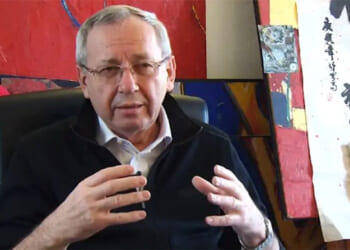The USS Gerald R. Ford’s deployment to the Caribbean, but away from the fragile situation in the Middle East, raises serious questions about America’s military readiness.
The deployment of the United States Navy’s newest, largest, and arguably most capable nuclear-powered supercarrier to the Caribbean highlights that we may be living in a time of multiple realities. Even the previous sentence is a reminder of that fact.
The USS Gerald R. Ford (CVN-78), the lead vessel of a new class of aircraft carriers, is still ironing out some bugs. She is the largest and newest carrier. And this reporter isn’t alone in often writing that she is the “arguably most capable,” because. Despite being the newest, CVN-78 isn’t carrying the F-35C Lightning II; her air wing consists solely of the F/A-18 Super Hornet. It is therefore not as capable as some of the Navy’s older carriers that can embark the F-35. Of course, the Super Hornet is still an effective multirole aircraft, but it doesn’t have the stealth of the F-35.
So why can’t the newest carrier operate with the F-35 when some older Nimitz-class carriers can? The issue is that the carrier was delivered before all necessary F-35C support equipment and software were installed. At least the next Ford-class carrier, the now delayed USS John F. Kennedy (CVN-79), was built to operate the F-35C when it finally enters service, as will subsequent Ford-class flattops.
Is the Ford Deployment a Show of Strength—or Weakness?
Although we’re not in any comic-book styled “multiverse,” it does feel like it at times, based on the way the deployment of USS Gerald R. Ford to the Caribbean is being reported.
According to Fox News, “[The] state-of-the-art warship steam[ed] for Venezuela to turn the tide in Trump’s war on drugs,” while The Hill opinion contributor Arturo McFields described the Ford as “the best negotiator against Maduro’s regime.” However, as the Associated Press reminded readers, Trump’s decision to send the Ford to the coast of South America left a conspicuous absence of carriers in both Europe and the Middle East.
In short, the deployment of the supercarrier is a true 21st-century gunboat diplomacy on a grand scale. At the same time, it leaves the US Navy stretched thin.
The decision to deploy CVN-78 to the Caribbean was made as it seemed it was “mission accomplished” in the Middle East. Now, however, the peace may not hold. Last year, the US ramped up the deployment of carriers to the region, which left the Indo-Pacific devoid of a carrier.
The Navy Doesn’t Have Enough Carriers for This Mission
On paper, the United States Navy has 11 nuclear-powered aircraft carriers; however, the numbers don’t add up.
Mark Cancian, a senior fellow at the Center for Strategic and International Studies and a retired Marine colonel, told AP that typically only three of the 11 US nuclear-powered aircraft carriers are at sea at any given time.
That number can be increased by extending a carrier’s deployments, which the US Navy did last year to ensure a near constant carrier presence in the Middle East. Numerous carriers were rotated to the region; each was actively involved in protecting commercial shipping and carrying out strikes on the Iranian-backed Houthi militants in Yemen. By contrast, unless Washington plans shock-and-awe-style strikes on Venezuela, it isn’t clear why deploying a carrier was even necessary.
The United States Air Force was already able to send B-52 Stratofortress and B-1B Lancer bombers on patrol missions near the South American nation that the administration has declared a narco-terrorist state, and there were already multiple Arleigh Burke-class guided-missile destroyers operating in the Caribbean. United States Marine Corps F-35Bs are now operating from Puerto Rico.
A supercarrier and its strike group add significantly more firepower, but it may be a bigger stick than necessary. Moreover, the resources that come with a carrier strike group’s deployment cannot easily be repositioned to other areas in the event of a crisis.
“It’s such a powerful and scarce resource, there will be a lot of pressure to do something or send it elsewhere,” Cancian said. “You can imagine the peace negotiations breaking down in the eastern Mediterranean or something happening with Iran.”
War in Venezuela Could Be a Disaster for the United States
In his op-ed for The Hill, McFields wrote, “Dictators like Maduro aren’t going to go away just by destroying a couple of boats. The regime is convinced that the US is playing a strategy of pressure and nothing more. The tyrant from Miraflores survived Trump’s first administration, the sanctions, the pandemic, international isolation, and even the threat of invasion.”
McFields then added, “Now he wants to repeat the formula — but he’s got it all wrong,” suggesting that regime change is now a matter of when, not if. According to the exiled journalist and former Nicaraguan ambassador to the Organization of American States, Maduro’s options are limited, and include his fleeing to Moscow as Syria’s Bashar al-Assad did last year, or “die clinging to power like Muammar Gaddafi” in Libya.
Yet, that assumes that the United States is willing to follow through with what could be a significant conflict. Air strikes in the 1990s didn’t remove Saddam Hussein from power in Iraq, and it took a massive invasion with international support to bring “regime change.”
That didn’t exactly work out all that well.
Trump has claimed, somewhat dubiously, that he has ended eight wars. However, by deploying a carrier to South America, it now appears he’s determined to start one. It won’t likely be quick or clean, even with a carrier supporting the operations.
About the Author: Peter Suciu
Peter Suciu has contributed over 3,200 published pieces to more than four dozen magazines and websites over a 30-year career in journalism. He regularly writes about military hardware, firearms history, cybersecurity, politics, and international affairs. Peter is also a contributing writer for Forbes and Clearance Jobs. He is based in Michigan. You can follow him on Twitter: @PeterSuciu. You can email the author: [email protected].
Image: Shutterstock.


















